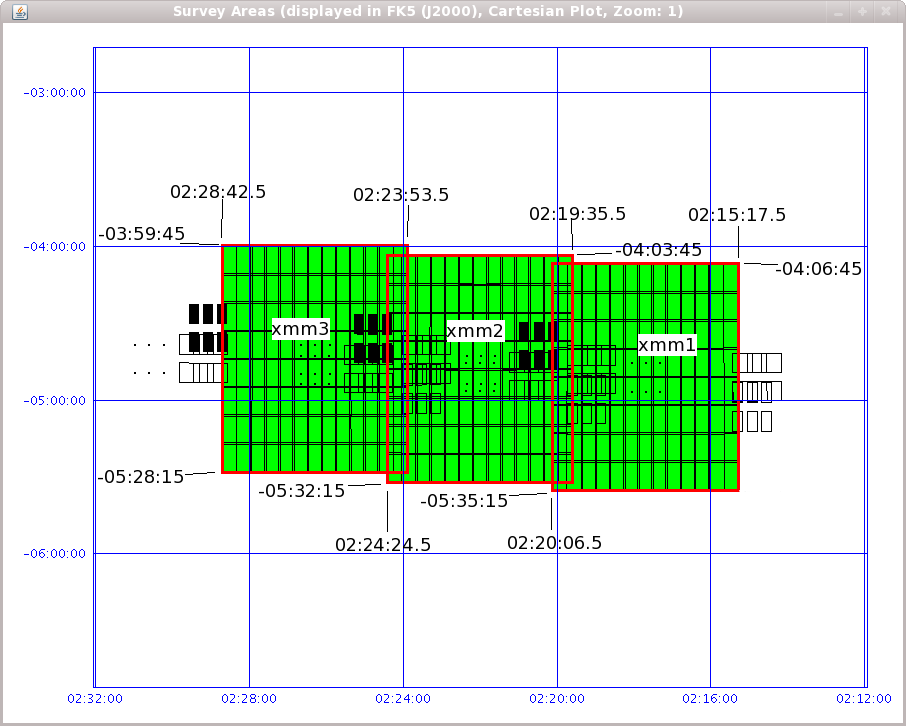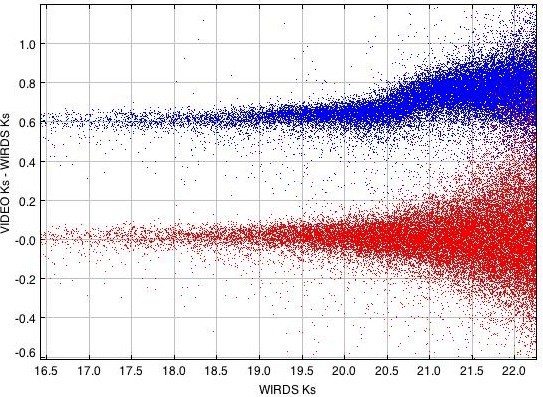VISTA Deep Extragalactic Observations Survey - Data Release 1
Provided by Matt Jarvis
Release Date: 25.07.2011
Abstract
This is the first data release for the VISTA Deep Extragalactic Observations (VIDEO) Survey, PI Matt Jarvis. This data release is comprised of imaging, confidence maps and catalogues for the VIDEO survey currently being conducted on ESO's VISTA. Imaging over the XMM3 tile of the VIDEO survey in Y, J, H and Ks filters is released covering ~1.5 square degrees.
Overview of Observations

Release Content
This data release includes all tiles from the Dry Run phase over the XMM3 (see Figs 1) tile of the VIDEO Survey. The observations are summarised in Table 1.
| Filter | Integration/tile | Integration/pixel | Number of Tiles |
|---|---|---|---|
| Y | 2880 sec | 960 sec | 23 |
| J | 2880 sec | 960 sec | 29 |
| H | 2520 sec | 840 sec | 21 |
| Ks | 2520 sec | 840 sec | 24 |
Table 1. Tiles released
Full details of the files released can be found in release_content.txt (plain ASCII format).
The next data release will include stacked images and aperture matched photometry from these deep stacks.
Data Reduction and Calibration
The reduction of this data was carried out at the Cambridge Astronomy Survey Unit as part of the VISTA Data Flow System. Full details of the reduction, calibration based on 2MASS and the catalogue generation for this release can be found at http://casu.ast.cam.ac.uk/surveys-projects/vista/technical/data-processing. Here we provide a brief summary of the steps implemented in generating the tiles for the VIDEO survey.
- Reset correction: Reset frames are taken for each exposure and are subtracted in the data acquisition system.
- Dark correction: the dark current is estimated from a series of exposures taken with a dark filter inserted and then subtracted.
- Linearity correction: the VISTA detectors do not have a linear response. To estimate the non-linearity of each detector we need information on the readout timing, the exposure time and the reset image timing (this is because there is no shutter on the camera and in double-correlated sampling mode, the default, the reset frame is subtracted prior to writing images to disk).
- Flat field correction: dividing by a mean twilight flatfield image removes the small scale QE variations in the detector as well as the large scale vignetting profile of the camera. We also use the global flatfield properties of each detector to gain-normalise each detector to a common (median) system.
- Sky background correction: this removes the large scale spatial background emission that comes from the atmosphere as well as several remaining additive effects. The 2d background map is estimated using several different algorithms that combine the science images themselves with masking of bright objects. Subsequent releases will use a mask based on the deep stacked images for more accurate sky subtraction
- Destripe: the readout electronics for the VISTA detectors introduce a low-level horizontal stripe pattern into the background. This is removed as a processing step.
- Jitter stacking: At this point in the reduction the jitter series is shifted and combined to form a single image stack, using positions of detected objects on all the detectors to compute the shifts. This allows bad pixel regions in one exposure to be rejected in favour of good pixels in other exposures.
- Catalogue generation: information on astronomical objects on the stacked image are extracted at this point. The parameters include positions, fluxes, and shape descriptors which are combined to generate object morphological classifications and form the basis for calibration and QC information.
- Astrometric and photometric calibration: objects on the catalogues are matched by their counterparts in the 2MASS point source catalogue. Because 2MASS has such a high degree of internal consistency it is possible to calibrate the world coordinate system of VISTA images to better than 50 milli-arcseconds. The 2MASS magnitudes are also used in conjunction with colour equations (see below) to provide photometric zeropoints to an accuracy of 1-2% (depending upon the wave band).
- Tiling: the overlap areas in VISTA pawprints needed to form a contiguous tile are large, so the pawprints are combined into tiles. Once this is done the catalogue step is repeated.
Colour equations based on 2MASS photometry (See Hodgkin S. et al., 2009, MNRAS, 394, 675, “The UKIRT wide field camera ZYJHK photometric system: calibration from 2MASS”)
ZVIDEO = J2MASS+1.025(J2MASS-H2MASS)
YVIDEO = J2MASS+0.610(J2MASS-H2MASS)
JVIDEO = J2MASS-0.077(J2MASS-H2MASS)
HVIDEO = H2MASS+0.032(J2MASS-H2MASS)
KsVIDEO = Ks2MASS+0.01(J2MASS-Ks2MASS)
Release Notes
For this release we include all data, even those data that do not strictly meet the seeing criteria set out for the VIDEO survey. For example, many of the tiles have a seeing of >0.8 arcsec (the specified seeing limit for VIDEO). We include these to enable the user to explore the full data set for time variable sources and other science that do not crucially depend on the higher resolution imaging. In future releases these data may not be included in the deep-stacked images due to increasing the noise. This will be fully documented. However, we will continue to release all imaging data accrued as part of the VIDEO survey, even when it does not meet the quality for the deep stacks, for use by the community.
In April 2011 we found an error in the photometry at the faint magnitudes (KAB>20.5) due to non-optimal sky subtraction (see Fig. 2). The data has not been corrected for this in this data release as the depth of the individual tiles is unaffected, however it would be affected if these tiles were stacked. The data is currently being re-reduced to correct for this and the next data release will have all of the correct photometry and the deep stacked data. The photometric accuracy for objects with KAB<20 meets the intended accuracy of <2% global photometry.

File naming convention
A list of the tiles is provided in release_content.txt. The corresponding confidence images have the same filename but with _conf and the corresponding source catalogues have a _cat appended.
Data retrieval
Go to the data products query form to find and retrieve the data from the ESO Science Archive. Just press the Search button to find all data belonging to this release, or specify search constraints to find a subset thereof.
Acknowledgements
Users of data products provided in this release are required to acknowledge the source of the data with an appropriate citation in their publications in the form:
Based on data products from observations made with ESO Telescopes at the La Silla or Paranal Observatories under ESO programme ID 179.A-2006.
